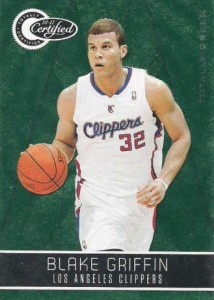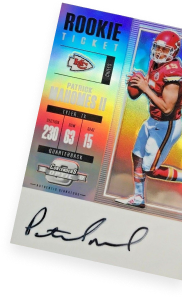Basketball collectors shelling out green for one shade of Totally Certified parallels
By Susan Lulgjuraj | Contributing Editor
With basketball season in full swing, collectors seem to be jumping for cards once again – even if there isn’t a single new NBA product out just yet.
It seems as though last season’s parallels from Panini America’s 2010-11 Totally Certified are doing extremely well on the secondary market.
But there is one parallel in particular that collectors seem to want more than others.
Perhaps there’s just something about the color green that we like.
“These cards have been selling substantially well over the past few months – many trying to compare them to the much more elusive Metal Gem Green cards – and many (on several different message boards) questioning the validity of the prices paid,” Rob Springs, Beckett Basketball analyst said. “I’m not sure these are the hottest cards in the hobby right now.”
The basic green parallels and the autographed parallels are numbered to five.
Recently, a Kevin Durant Totally Certified green autograph sold for $1,800 on eBay and a Derrick Rose autograph came in behind him for $1,495.
But these cards don’t need a signature to be worth big bucks. A LeBron James numbered 4/5 sold for $1,200 on Jan. 30. That’s right. No autograph, just a shiny green parallel to add to someone’s collection. The non-autographed Kobe Bryant sold for $999.
Even some of the less-popular players sell for a decent amount of money from a hobby box that runs for about $140. On the bottom end of the scale, a Brook Lopez autograph sold for $45.
But on the average, many of the green parallels have sold for $100-plus.
Susan Lulgjuraj is a contributing editor for Beckett Media. You can email Susan here. Follow her on Twitter here.







If I had the money, I would be going after these too!!! I’m not too big on autographs, if I have one card with an auto on it, I see no need to chase another really..just my preference. I really like seeing this in the secondary market. I think people are too hung up on autos and relics too enjoy anything else and like you said these cards don’t need a signature to be worth big bucks and I think that is awesome.
Meanwhile you can get some 1/1 cards of the same players for much less.
Sorry, but this is a fail. You can sometimes make a point for some of the parallels
like the Topps ones because you have enough obsessive collectors wanting to put
together master sets.
The metal gems sell high because there are a few insane collectors who have latched
onto it and because they are harder to get in the packs to begin with as well as being
a sub-set of base parallel where only the first 10 were green and the rest red. At
the time, it was an innovation much in the way the 93 Finest refractors were, and other
sets came out with the first X being die cut or autographed, etc.
Years ago I was at the National and one Japanese collector had a display case full of
these. He was BUYING for his personal collection or perhaps getting them for someone
else, but his demand ate into the supply and those people who wanted to get one had
to compete with people with more money and ….
Expect that over the long run that these parallels will NOT be big deals except for the
rookie cards.
This is ridiculous. It is probably driven by one or two super-collectors.
In 1998 a customer pulled a PMG Green Michael Jordan #d/10 from my store. At the time, it sold for about $150 and I thought that was crazy. But, it helped sell boxes and it was good for the hobby.
Since value is the result of supply and demand, even the rarest of cards have little value unless there is significant demand. This hobby needs something to generate excitement in the chase. The current response to 2010-11 Totally Certified Basketball is good for the hobby. It sells boxes.
This hobby continues to look for the next great thing. Great autographs, sick patches, improved product designs, video cards, solid gold cards, diamonds on cards are all moves in the right direction. But, this hobby needs more great ideas and maybe looking back to the 90′s is part of the answer.
Again, supply and demand determine value, and there just aren’t as many collectors in this hobby as we had in the 90′s. The fact is, we don’t have many set builders putting together numbered sets. I love numbered cards, but too many layers of parallels just cheapens the value of low numbered parallels. Hopefully, the card manufacturers can expand upon this product’s success by coming up with products with rare inserts/parallels which are not just one of many layers of parallels.
I am on the same page as Charlie DiPietro regardinghis supply & demand comments. Collectors just want the next big thing. I do not think the Certified Green cards are going to have that much heat a year or two from now. The RC’s will hold value, but the others will drop in price.. at least a little. These type of cards do sell boxes, but think… the average collector can not afford to bust a ton of wax… They buy on the secondary market, which is lost money to cardboard manufacturers, unless they hold some product to give to a partner to sell for them, then providing a kickback… which in my opinion does happen more than you would think. It is extremely hard for one collector to have all 1/1 cards of a certain player out of one product… especially when they first are released. Hard to think the guy pulled them all or bought them, especially when they never showed up on ebay or any other website.. Just impossible.
Bring back the 90’s ideas… add autos & serials #’s… Don’t have 50 different cards, all numbered to 24, all of the same player, all auto, all in the same product… this brings down cost. You can pick up a Panini Kobe auto for $120… that is less than the costs of some boxes and/or packs… why would I buy another box of Elite Black Box, if I can pick up an kobe auto for less than the price of a box….??
People open wax based on the chance at getting a great card, the rest of the cards being “profit”. It’s a lottery ticket with at least a little something left over.
I personally don’t like super expensive products and I hate them when you do not get any
value on too large a percentage of them. A good product will return, on average,
about 60-80% “value” after opened. This means if sold on the secondary market, not that
they “book” for a specific amount. If open an expensive product and all you get is a plain
one color jersey of a no name (relatively speaking) player you have a right to feel a bit
cheated.
Really, the expensive products were the answers to the “commons” question.
They took all the “inserts” of a group of boxes, eliminated the “junk”, and put in a box
for a bit less the same cost of those original boxes combined.
Thing is, even commons had some value. Granted, we usually gave them to the shop,
but that helped the shop and often they would help you put a set together, etc.
More importantly, the 1/case card had a sort of cache to it. Everyone knew you had to
wade through a ton of junk to get it, so even a common case card still retained a bit of
value.
There is no easy answer that makes sense to both the hobby and the makers of cards.
The best thing to do for the hobby would be the reduction of products down to the point
where everyone starts recognizing the products and gets a chance to get excited again.
When a new product is coming out every few weeks people start to not care about a lot
of them. Some people will continue to chase a traditional basic product like Topps, Bowman,
etc. and other products that were once “great” fall away and get forgotten.
For a card to have value you need the following.
1) People have to know the card exists.
2) It has to be attractive to multiple people. This means the card is either part of a set that
is popular, a card of a desirable player, relatively low production, etc.
3) It has to become available every so often to keep people in the chase.
Meanwhile I got a Lebron Gold Rush 14k gold(real gold) /10 and I probably coulndn’t get but a few hundred and other players are waay less…….These greens are worth more than gold??? One word- Crazy.
I just pulled a Kobe Green Auto! First box I opened in YEARS!